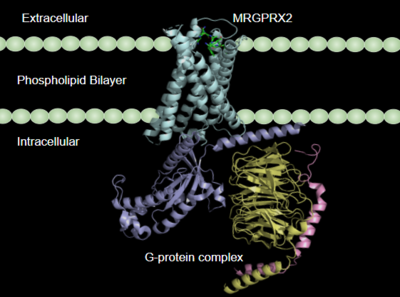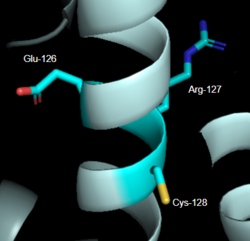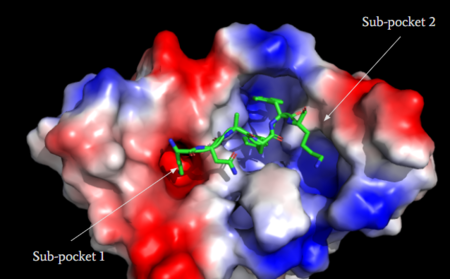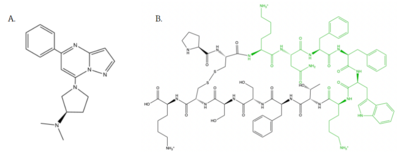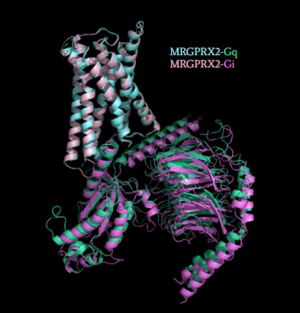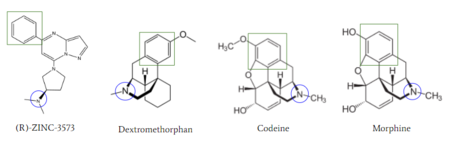Sandbox Reserved 1722
From Proteopedia
(Difference between revisions)
| Line 6: | Line 6: | ||
== G-Protein Coupled Receptors == | == G-Protein Coupled Receptors == | ||
| - | [[Image:Newmembrane.PNG|400px|right|thumb|'''Figure 1''':MRGPRX2 in the cellular membrane | + | [[Image:Newmembrane.PNG|400px|right|thumb|'''Figure 1''':MRGPRX2 in the cellular membrane <ref name="Cao"/>.]] |
[https://proteopedia.org/wiki/index.php/G_protein-coupled_receptors G-protein coupled receptors](GCPRs) are a large family of cell surface membrane receptors. Once bound to a wide variety of extracellular ligands, GCPRs undergo a conformational change and relay information to intracellular secondary messengers <ref name="Thal">Thal, David M., et al. "Structural insights into G-protein-coupled receptor allostery." Nature, Nature Publishing Group, 04 July 2018, https://www.nature.com/articles/s41586-018-0259-z</ref>. This G protein activation results in a cellular response dependent on the ligand bound and location of the GPCR in the body. GCPRs can be broken down into five families: the [https://en.wikipedia.org/wiki/Rhodopsin-like_receptors rhodopsin family (class A)], the [https://en.wikipedia.org/wiki/Secretin_receptor_family secretin family (class B)], the [https://en.wikipedia.org/wiki/Adhesion_G_protein-coupled_receptor adhesion family], the [https://en.wikipedia.org/wiki/Class_C_GPCR glutamate family (class C)], and the [https://en.wikipedia.org/wiki/Frizzled frizzled/taste family (class F)] <ref name="Zhang">PMID: 26467290</ref>. All of the families have a similar transmembrane (TM) domain consisting of <scene name='90/904328/7tm_domain_pt_3/7'>seven α-helices</scene> complexed with intracellular G proteins (Figure 1). | [https://proteopedia.org/wiki/index.php/G_protein-coupled_receptors G-protein coupled receptors](GCPRs) are a large family of cell surface membrane receptors. Once bound to a wide variety of extracellular ligands, GCPRs undergo a conformational change and relay information to intracellular secondary messengers <ref name="Thal">Thal, David M., et al. "Structural insights into G-protein-coupled receptor allostery." Nature, Nature Publishing Group, 04 July 2018, https://www.nature.com/articles/s41586-018-0259-z</ref>. This G protein activation results in a cellular response dependent on the ligand bound and location of the GPCR in the body. GCPRs can be broken down into five families: the [https://en.wikipedia.org/wiki/Rhodopsin-like_receptors rhodopsin family (class A)], the [https://en.wikipedia.org/wiki/Secretin_receptor_family secretin family (class B)], the [https://en.wikipedia.org/wiki/Adhesion_G_protein-coupled_receptor adhesion family], the [https://en.wikipedia.org/wiki/Class_C_GPCR glutamate family (class C)], and the [https://en.wikipedia.org/wiki/Frizzled frizzled/taste family (class F)] <ref name="Zhang">PMID: 26467290</ref>. All of the families have a similar transmembrane (TM) domain consisting of <scene name='90/904328/7tm_domain_pt_3/7'>seven α-helices</scene> complexed with intracellular G proteins (Figure 1). | ||
=== Class A GCPRs === | === Class A GCPRs === | ||
| - | Class A GPCRS or [https://en.wikipedia.org/wiki/Rhodopsin-like_receptors rhodopsin-like GPCRS] are the largest and most studied type of GPCRS. | + | Class A GPCRS or [https://en.wikipedia.org/wiki/Rhodopsin-like_receptors rhodopsin-like GPCRS] are the largest and most studied type of GPCRS. These receptors are commonly found in [https://en.wikipedia.org/wiki/Mast_cell mast cells], an immune cell used in the inflammatory response. When these mast cells are activated, they will release [https://en.wikipedia.org/wiki/Granule granules] containing [https://en.wikipedia.org/wiki/Histamine histamine] and other inflammatory [https://en.wikipedia.org/wiki/Cytokine cytokines]. These mast cells are found in abundance in the digestive tract, trachea, and skin <ref name="Ramesh">Ramesh, Soliman, et al. (2015) "G-Protein Coupled Receptors (GPCRs): A Comprehensive Computational Perspective." Combinational Chemistry and High Throughout Screening, 18(4), 346-364, https://pubmed.ncbi.nlm.nih.gov/25747435/</ref>. They are characterized by conserved motifs including DRY, PIF, Sodium Binding, and the CWxP <ref name="Zhou">PMID: 31855179</ref>. A common example of a class A GPCRS is the [https://proteopedia.org/wiki/index.php/Beta-2_Adrenergic_Receptor#:~:text=Beta%2D2%20Adrenergic%20Receptors%20(B2ARs,with%20over%201000%20unique%20Isoforms. β2AR receptor], which is involved in the activation of the "fight or flight" system by the sympathetic nervous system<ref name="Cao">Cao, Can, et al. "Structure, function and pharmacology of human itch GPCRs." Nature, Nature Publishing Group, 17 November 2021, https://www.nature.com/articles/s41586-021-04126-6</ref>. |
| + | |||
=== MRGPRs === | === MRGPRs === | ||
| - | The human itch GPCR, or Mas-related G-protein coupled receptor (MRGPR), is a Class A GPCR found in human sensory neurons and is responsible for the sensation of “[https://en.wikipedia.org/wiki/Itch itching]” caused by skin irritation and diseases, insect bites, and hypersensitivity to certain drugs. MRGPR's are broken into 4 groups consisting of MRGPRX1, MRGPRX2, MRGPRX3, and MRGPRX4. MRGPRX4 is responsible for [https://en.wikipedia.org/wiki/Cholestatic_pruritus#:~:text=Cholestatic%20pruritus%20is%20the%20sensation,pruritus)%2C%20and%20chronic%20hepatitis%20C cholestatic itching], an intense itching felt during pregnancy on the soles of the feet and palms of hands. Meanwhile, MRGPRX2 regulates [https://en.wikipedia.org/wiki/Degranulation degranulation] and [https://en.wikipedia.org/wiki/Hypersensitivity#:~:text=Hypersensitivity%20(also%20called%20hypersensitivity%20reaction,may%20be%20damaging%20and%20uncomfortable. hypersensitivity] itch reactions <ref name="Cao">Cao, Can, et al. "Structure, function and pharmacology of human itch GPCRs." Nature, Nature Publishing Group, 17 November 2021, https://www.nature.com/articles/s41586-021-04126-6</ref>. These two, chiefly MRGPRX2, are often targets for drugs that result in mast cell degranulation and hypersensitivity side effects, such as swelling and itching. In comparison to other Class A GPCRs, MRGPRX2 binds to an even wider range of ligands, including agonists such as cationic small molecules and peptide ligands. | + | The human itch GPCR, or Mas-related G-protein coupled receptor (MRGPR), is a Class A GPCR found in human sensory neurons and is responsible for the sensation of “[https://en.wikipedia.org/wiki/Itch itching]” caused by skin irritation and diseases, insect bites, and hypersensitivity to certain drugs. MRGPR's are broken into 4 groups consisting of MRGPRX1, MRGPRX2, MRGPRX3, and MRGPRX4. MRGPRX4 is responsible for [https://en.wikipedia.org/wiki/Cholestatic_pruritus#:~:text=Cholestatic%20pruritus%20is%20the%20sensation,pruritus)%2C%20and%20chronic%20hepatitis%20C cholestatic itching], an intense itching felt during pregnancy on the soles of the feet and palms of hands. Meanwhile, MRGPRX2 regulates [https://en.wikipedia.org/wiki/Degranulation degranulation] and [https://en.wikipedia.org/wiki/Hypersensitivity#:~:text=Hypersensitivity%20(also%20called%20hypersensitivity%20reaction,may%20be%20damaging%20and%20uncomfortable. hypersensitivity] itch reactions <ref name="Cao">Cao, Can, et al. "Structure, function and pharmacology of human itch GPCRs." Nature, Nature Publishing Group, 17 November 2021, https://www.nature.com/articles/s41586-021-04126-6</ref>. These two, chiefly MRGPRX2, are often targets for drugs that result in mast cell degranulation and hypersensitivity side effects, such as swelling and itching. In comparison to other Class A GPCRs, MRGPRX2 binds to an even wider range of ligands, including agonists such as cationic small molecules and peptide ligands. Understanding the mechanism of MRGPRX2 could aid in developing antagonists that will prevent its overactivation. |
== Changes in MRGPRX2 from Standard Class A GPCRS == | == Changes in MRGPRX2 from Standard Class A GPCRS == | ||
Revision as of 13:16, 21 April 2022
| This Sandbox is Reserved from February 28 through September 1, 2022 for use in the course CH462 Biochemistry II taught by R. Jeremy Johnson at the Butler University, Indianapolis, USA. This reservation includes Sandbox Reserved 1700 through Sandbox Reserved 1729. |
To get started:
More help: Help:Editing |
Human Itch Mas-Related G-Protein Coupled Receptor
| |||||||||||
References
- ↑ 1.0 1.1 1.2 1.3 1.4 1.5 1.6 1.7 1.8 1.9 Cao, Can, et al. "Structure, function and pharmacology of human itch GPCRs." Nature, Nature Publishing Group, 17 November 2021, https://www.nature.com/articles/s41586-021-04126-6
- ↑ Thal, David M., et al. "Structural insights into G-protein-coupled receptor allostery." Nature, Nature Publishing Group, 04 July 2018, https://www.nature.com/articles/s41586-018-0259-z
- ↑ 3.0 3.1 Zhang D, Zhao Q, Wu B. Structural Studies of G Protein-Coupled Receptors. Mol Cells. 2015 Oct;38(10):836-42. doi: 10.14348/molcells.2015.0263. Epub 2015, Oct 15. PMID:26467290 doi:http://dx.doi.org/10.14348/molcells.2015.0263
- ↑ Ramesh, Soliman, et al. (2015) "G-Protein Coupled Receptors (GPCRs): A Comprehensive Computational Perspective." Combinational Chemistry and High Throughout Screening, 18(4), 346-364, https://pubmed.ncbi.nlm.nih.gov/25747435/
- ↑ 5.0 5.1 5.2 Zhou Q, Yang D, Wu M, Guo Y, Guo W, Zhong L, Cai X, Dai A, Jang W, Shakhnovich EI, Liu ZJ, Stevens RC, Lambert NA, Babu MM, Wang MW, Zhao S. Common activation mechanism of class A GPCRs. Elife. 2019 Dec 19;8. pii: 50279. doi: 10.7554/eLife.50279. PMID:31855179 doi:http://dx.doi.org/10.7554/eLife.50279
- ↑ 6.0 6.1 6.2 6.3 6.4 6.5 6.6 6.7 6.8 Yang, Fan, et al. "Structure, function and pharmacology of human itch receptor complexes." Nature, Nature Publishing Group, 17 November 2021, https://www.nature.com/articles/s41586-021-04077-y
- ↑ 7.0 7.1 Schonegge, Anne-Marie, et al. "Evolutionary action and structural basis of the allosteric switch controlling β2AR functional selectivity." Nature, Nature Publishing Group, 18 December 2017, https://www.nature.com/articles/s41467-017-02257-x
- ↑ Sandoval, A., et al. "The Molecular Switching Mechanism at the Conserved D(E)RY Motif in Class-A GPCRs." Biophysical journal, 111(1), 79-89. https://doi.org/10.1016/j.bpj.2016.06.004
- ↑ Katritch V, Fenalti G, Abola EE, Roth BL, Cherezov V, Stevens RC. Allosteric sodium in class A GPCR signaling. Trends Biochem Sci. 2014 May;39(5):233-44. doi: 10.1016/j.tibs.2014.03.002. Epub , 2014 Apr 21. PMID:24767681 doi:http://dx.doi.org/10.1016/j.tibs.2014.03.002
- ↑ Babina, M., et al. "MRGPRX2 Is the Codeine Receptor of Human Skin Mast Cells: Desensitization through β-Arrestin and Lack of Correlation with the FcεRI Pathway." Journal of Investigative Dermatology, 141(6), 1286-1296. https://doi.org/10.1016/j.jid.2020.09.017
- ↑ McNeil, B. D., et al. "MRGPRX2 and Adverse Drug Reactions." Frontier Immunology, 06 August 2021, https://www.frontiersin.org/articles/10.3389/fimmu.2021.676354/full
- ↑ Ogasawara, H., et al. "Novel MRGPRX2 antagonists inhibit IgE-independent activation of human umbilical cord blood-derived mast cells." Journal of Leukocyte Biology, 12 July 2019, https://jlb.onlinelibrary.wiley.com/doi/10.1002/JLB.2AB1018-405R
